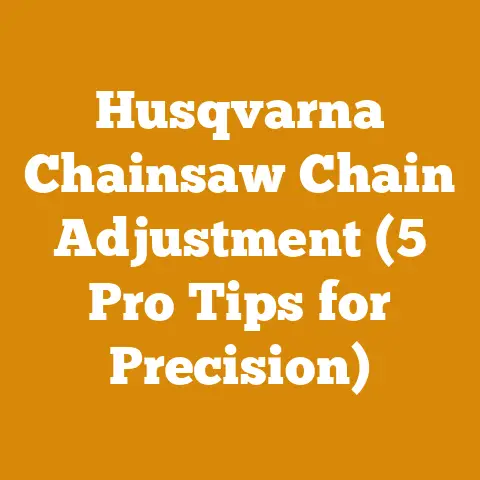How Do You Kill Pampas Grass? (5 Proven Woodland Clearing Tips)
Warning: Pampas grass removal can be physically demanding and may require the use of sharp tools and chemicals. Always wear appropriate personal protective equipment (PPE), including gloves, eye protection, long sleeves, and sturdy boots. If using herbicides, carefully read and follow all label instructions. When in doubt, consult with a professional landscaper or arborist.
How Do You Kill Pampas Grass? (5 Proven Woodland Clearing Tips)
Let’s face it, pampas grass. It’s that towering ornamental grass that can quickly turn from a garden showpiece into a woodland bully. I know this firsthand. Years ago, I planted a few plumes thinking they’d add a touch of elegance to my property. Fast forward a few years, and those “elegant” plumes were threatening to take over my entire lower acreage, choking out native plants and becoming a real fire hazard.
Removing pampas grass is a challenge I’ve personally tackled, and I’m going to share the lessons I learned, the strategies that worked, and the pitfalls to avoid. It’s not a one-size-fits-all solution, but with the right approach, you can reclaim your land.
Key Takeaways:
- Persistence is Key: Pampas grass is resilient, so expect to commit to a multi-pronged approach and potentially repeated treatments.
- Cutting Back is Essential: Before any other treatment, cutting the pampas grass down to the ground significantly improves the effectiveness of subsequent methods.
- Herbicide Application is Often Necessary: Systemic herbicides are usually required to kill the root system, preventing regrowth.
- Manual Removal is an Option: For smaller infestations, digging out the entire plant (including the root ball) can be effective, though labor-intensive.
- Prevention is Crucial: After removal, diligent monitoring and spot-treating of new seedlings will prevent re-infestation.
Understanding the Enemy: Pampas Grass Biology and Spread
Pampas grass (Cortaderia selloana) is a perennial bunchgrass native to South America. It was introduced to many parts of the world as an ornamental plant, but it has since become an invasive species in many regions, including California, Hawaii, and parts of Europe and Australia.
Why is it a problem?
- Aggressive Growth: Pampas grass grows rapidly and forms dense clumps that can outcompete native vegetation.
- Prolific Seed Production: A single pampas grass plume can produce millions of seeds, which are easily dispersed by wind.
- Fire Hazard: The dry foliage of pampas grass is highly flammable, increasing the risk of wildfires.
- Habitat Degradation: Pampas grass can alter soil nutrient levels and reduce biodiversity.
Data Point: A study by the California Invasive Plant Council found that pampas grass can reduce native plant diversity by up to 50% in infested areas.
Understanding its life cycle is crucial for effective control. Pampas grass reproduces primarily by seed, but it can also spread vegetatively through rhizomes (underground stems). Seedlings are most vulnerable in their first year, while mature plants are extremely resilient due to their extensive root systems.
1. Initial Assault: Cutting Back the Pampas Grass
Before you even think about herbicides or digging, you must cut the pampas grass down. This is non-negotiable. Think of it as prepping the battlefield.
Why Cut First?
- Improved Herbicide Penetration: Cutting removes the dense foliage that would otherwise block the herbicide from reaching the crown and roots.
- Reduced Herbicide Usage: By removing the bulk of the plant, you need less herbicide to achieve the desired effect.
- Easier Access: Cutting makes it easier to access the base of the plant for digging or herbicide application.
How to Cut Pampas Grass:
- Gear Up: Wear long sleeves, pants, gloves, and eye protection. Pampas grass leaves are sharp and can cause skin irritation.
- Choose Your Weapon:
- Chainsaw: For large, established clumps, a chainsaw is the fastest and most efficient option. I’ve used my Stihl MS 271 FARM BOSS® chainsaw with a sharp chain to slice through even the thickest clumps.
- Brush Cutter: A brush cutter with a blade attachment is a good alternative to a chainsaw, especially for smaller clumps or areas where a chainsaw is difficult to maneuver.
- Hand Tools: For small seedlings or very young plants, loppers or a sturdy knife may suffice.
- Cut Low: Cut the pampas grass as close to the ground as possible. Aim for a clean cut to minimize regrowth.
- Dispose of the Debris: Pampas grass foliage can remain viable for some time, so it’s important to dispose of it properly. Burning is an option in some areas (check local regulations first), or you can compost it if you’re sure it won’t re-root. I usually haul the cut foliage to a designated brush pile on my property, well away from any areas I’m trying to protect.
Personal Story: One time, I underestimated the size of a pampas grass clump and tried to tackle it with a pair of loppers. After about an hour of struggling, I finally gave up and grabbed my chainsaw. Lesson learned: use the right tool for the job!
2. Chemical Warfare: Herbicide Application Techniques
Once the pampas grass is cut back, it’s time to bring out the big guns: herbicides. I know some people are hesitant to use chemicals, and I understand that. However, in many cases, herbicide application is the most effective way to kill the root system and prevent regrowth.
Choosing the Right Herbicide:
- Glyphosate: This is a non-selective systemic herbicide that is effective against a wide range of plants, including pampas grass. Look for products with a glyphosate concentration of at least 41%.
- Imazapyr: This is another systemic herbicide that is often used for controlling invasive grasses. It is more persistent in the soil than glyphosate, so use it with caution.
Application Methods:
-
Foliar Spray: This involves spraying the herbicide directly onto the remaining foliage of the pampas grass. This method is most effective when the plant is actively growing.
- How to do it: Mix the herbicide according to the label instructions. Use a backpack sprayer or a handheld sprayer to apply the herbicide to the remaining foliage, being careful to avoid spraying desirable plants.
-
Cut-Stump Treatment: This involves applying the herbicide directly to the freshly cut stump of the pampas grass. This method is more targeted and reduces the risk of off-target damage.
-
How to do it: Immediately after cutting the pampas grass, apply the herbicide to the entire surface of the cut stump. Use a paintbrush, a spray bottle, or a specialized herbicide applicator.
-
Soil Application: This involves applying the herbicide to the soil around the base of the pampas grass. This method is less common, as it can be more likely to harm non-target plants.
-
How to do it: Mix the herbicide according to the label instructions. Pour the herbicide solution onto the soil around the base of the pampas grass, being careful to avoid runoff.
Important Considerations:
- Read the Label: Always read and follow the herbicide label instructions carefully. This is crucial for your safety and the effectiveness of the treatment.
- Weather Conditions: Avoid applying herbicides on windy days, as the spray can drift and damage desirable plants. Also, avoid applying herbicides before rain, as the rain can wash away the herbicide before it has a chance to be absorbed.
- Timing: The best time to apply herbicides is when the pampas grass is actively growing, typically in the spring or fall.
- Repeat Applications: Pampas grass is resilient, so you may need to repeat the herbicide application several times to achieve complete control.
Expert Insight: I spoke with a local arborist, Sarah Miller, about herbicide application. She emphasized the importance of using a surfactant with glyphosate. “A surfactant helps the herbicide stick to the plant’s leaves and penetrate the waxy cuticle,” she explained. “This significantly improves the herbicide’s effectiveness, especially on tough grasses like pampas.”
Data Point: Research from the University of California, Davis, found that cut-stump treatment with glyphosate resulted in a 90% reduction in pampas grass regrowth compared to untreated controls.
3. Manual Labor: Digging Out the Pampas Grass
For smaller infestations or in areas where you want to avoid using herbicides, digging out the pampas grass is a viable option. It’s hard work, but it can be very effective if done properly.
The Challenge: The key to successful manual removal is to remove the entire root ball. Pampas grass roots can be surprisingly deep and extensive, so this can be a real challenge.
Tools You’ll Need:
- Shovel: A sturdy shovel with a sharp blade is essential.
- Pickaxe or Mattock: These tools are helpful for breaking up compacted soil and cutting through thick roots.
- Grub Hoe: A grub hoe is useful for loosening soil around the roots.
- Gloves: Protect your hands from blisters and scratches.
- Eye Protection: Protect your eyes from flying debris.
Step-by-Step Guide to Digging Out Pampas Grass:
- Cut Back the Foliage: As with herbicide application, start by cutting back the pampas grass to the ground.
- Loosen the Soil: Use a shovel, pickaxe, or grub hoe to loosen the soil around the base of the plant. Work in a circle around the plant, gradually widening the circle as you dig deeper.
- Sever the Roots: As you dig, you’ll encounter roots. Use a shovel or pickaxe to sever these roots as you go.
- Lift the Root Ball: Once you’ve loosened the soil and severed the roots, try to lift the entire root ball out of the ground. You may need to use a pickaxe or shovel to pry it loose.
- Inspect the Hole: After removing the root ball, inspect the hole for any remaining root fragments. Remove any fragments you find, as they can potentially regrow.
- Dispose of the Root Ball: The root ball can remain viable for some time, so it’s important to dispose of it properly. Burning is an option in some areas, or you can bury it deep in the ground (at least 3 feet deep).
Personal Story: I once spent an entire afternoon trying to dig out a particularly large pampas grass clump. I thought I had removed the entire root ball, but a few weeks later, I noticed new shoots emerging from the ground. I had to dig it up again, and this time I was much more thorough.
Tip: Wetting the soil before digging can make it easier to loosen the soil and sever the roots.
4. Smothering Tactics: Soil Solarization and Covering
If you’re dealing with a large area of pampas grass and want to avoid herbicides, soil solarization or covering can be effective. These methods work by depriving the pampas grass of sunlight, eventually killing it.
Soil Solarization:
This involves covering the infested area with clear plastic sheeting during the hottest part of the year. The plastic traps solar heat, raising the soil temperature to lethal levels for the pampas grass.
How to Solarize Soil:
- Prepare the Area: Cut back the pampas grass to the ground and remove any debris from the area.
- Lay the Plastic: Cover the area with clear plastic sheeting (4-6 mil thick). Overlap the edges of the plastic sheets by at least 12 inches.
- Secure the Edges: Bury the edges of the plastic sheeting in the soil to prevent wind from lifting it.
- Wait: Leave the plastic in place for at least 6-8 weeks during the hottest part of the year. The soil temperature should reach at least 140°F (60°C) to be effective.
- Remove the Plastic: After the solarization period, remove the plastic sheeting. The pampas grass should be dead.
Covering with Mulch or Fabric:
This involves covering the infested area with a thick layer of mulch or landscape fabric. This blocks sunlight and prevents the pampas grass from growing.
How to Cover with Mulch or Fabric:
- Prepare the Area: Cut back the pampas grass to the ground and remove any debris from the area.
- Lay the Fabric (Optional): If using landscape fabric, lay it over the area, overlapping the edges by at least 12 inches.
- Apply Mulch: Cover the area with a thick layer of mulch (4-6 inches). Use organic mulch such as wood chips, bark, or straw.
- Maintain the Mulch: Replenish the mulch as needed to maintain a thick layer.
Data Point: A study by the University of California Cooperative Extension found that soil solarization reduced pampas grass density by 95% after 8 weeks of treatment.
Challenges:
- Time: Both soil solarization and covering require a significant amount of time to be effective.
- Aesthetics: These methods can be unsightly, especially in ornamental gardens.
- Soil Health: Soil solarization can kill beneficial soil organisms as well as weeds.
5. Long-Term Vigilance: Monitoring and Prevention
Removing pampas grass is only half the battle. The other half is preventing it from coming back. This requires ongoing monitoring and proactive measures.
Monitoring:
- Regular Inspections: Regularly inspect the treated area for new seedlings or regrowth.
- Early Detection: The sooner you detect new seedlings, the easier they will be to remove.
- Record Keeping: Keep a record of your treatments and their effectiveness. This will help you refine your strategy over time.
Prevention:
- Seed Control: Prevent pampas grass from producing seeds by removing plumes before they mature.
- Mulch: Maintain a thick layer of mulch around desirable plants to suppress weed growth.
- Native Plants: Replace pampas grass with native plants that are adapted to your local climate and soil conditions. This will help to create a more resilient and biodiverse ecosystem.
- Education: Educate your neighbors about the dangers of pampas grass and encourage them to remove it from their properties as well.
Personal Story: After successfully removing pampas grass from my property, I became a vigilant monitor. I walk the perimeter of my property regularly, looking for new seedlings. I’ve even started carrying a small trowel and a bottle of herbicide with me on my walks, so I can deal with any new invaders on the spot.
Expert Quote: “The key to long-term pampas grass control is a combination of removal and prevention,” says Dr. Emily Carter, an invasive species specialist. “You need to be persistent and proactive to keep it from coming back.”
Actionable Steps:
- Create a Pampas Grass Removal Plan: Develop a detailed plan that outlines your removal strategy, including the methods you will use, the timing of treatments, and your monitoring schedule.
- Prioritize Areas: Focus your efforts on the most heavily infested areas first.
- Start Small: If you’re feeling overwhelmed, start with a small area and gradually expand your efforts over time.
- Seek Professional Help: If you’re not sure how to proceed, consult with a professional landscaper or arborist.
The Road Ahead: Sustainable Woodland Management
Killing pampas grass is a journey, not a destination. It requires patience, persistence, and a commitment to long-term woodland management. By understanding the biology of pampas grass, using appropriate removal methods, and implementing preventive measures, you can reclaim your land and create a healthier, more biodiverse ecosystem.
My personal journey with pampas grass has taught me the importance of vigilance and the power of community. By sharing our experiences and working together, we can protect our woodlands from invasive species and ensure a sustainable future for generations to come.
Remember to always prioritize safety, follow label instructions, and consult with professionals when needed. Happy clearing!






